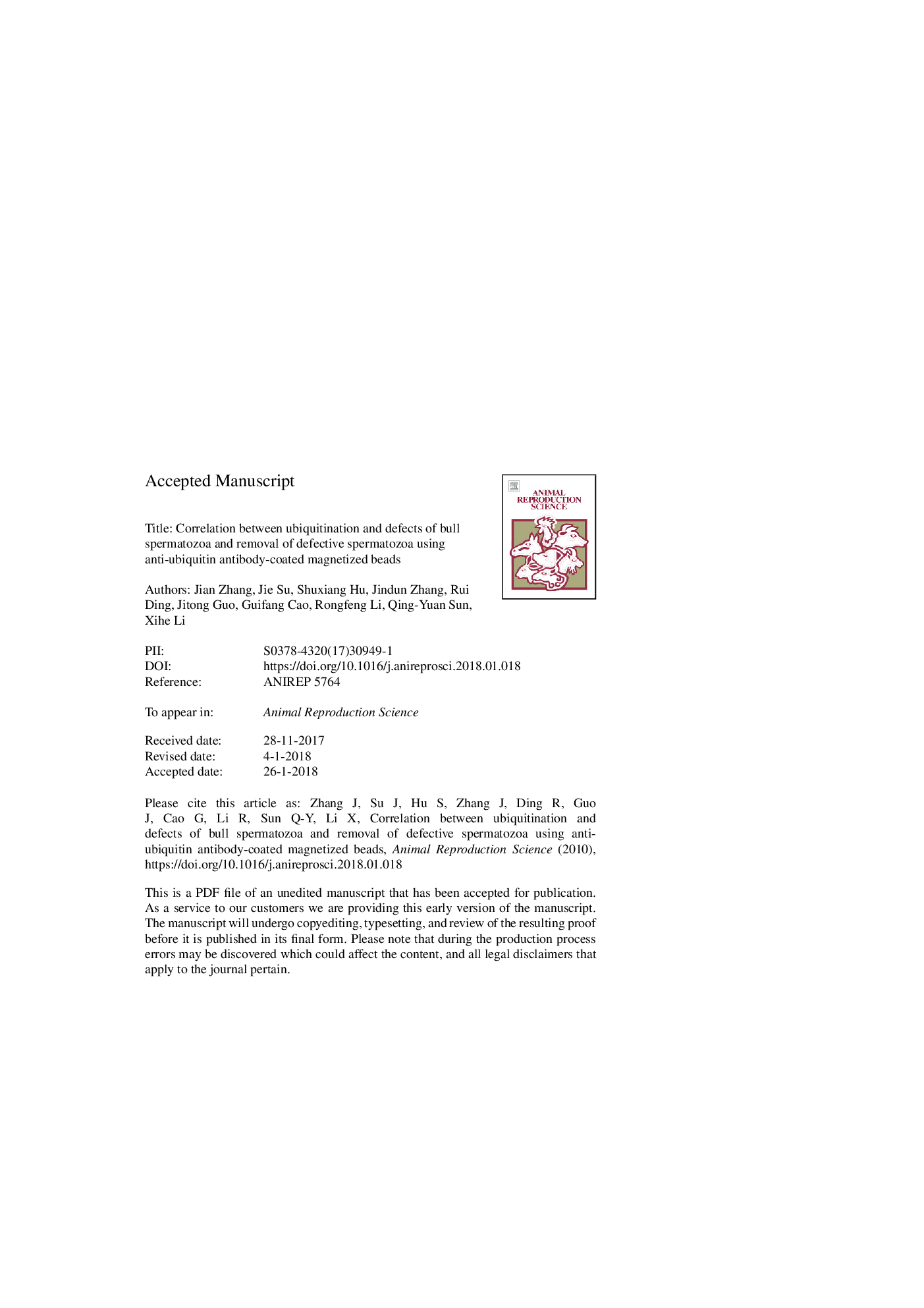| کد مقاله | کد نشریه | سال انتشار | مقاله انگلیسی | نسخه تمام متن |
|---|---|---|---|---|
| 8403865 | 1544685 | 2018 | 30 صفحه PDF | دانلود رایگان |
عنوان انگلیسی مقاله ISI
Correlation between ubiquitination and defects of bull spermatozoa and removal of defective spermatozoa using anti-ubiquitin antibody-coated magnetized beads
دانلود مقاله + سفارش ترجمه
دانلود مقاله ISI انگلیسی
رایگان برای ایرانیان
کلمات کلیدی
موضوعات مرتبط
علوم زیستی و بیوفناوری
علوم کشاورزی و بیولوژیک
علوم دامی و جانورشناسی
پیش نمایش صفحه اول مقاله

چکیده انگلیسی
Ubiquitination is an important cellular process in spermatogenesis and involves the regulation of spermatid differentiation and spermiogenesis. In the current study, the correlation between bull sperm ubiquitination and sperm defects was analyzed, and the feasibility using anti-ubiquitin specific antibody immobilized magnetic beads to remove the spermatozoa with defects was assessed. A total of nine bulls were examined, and the amount of sperm ubiquitination ranged from 55 to 151. Correspondingly, the percentage of sperm deformity ranged from 9.3% to 28.1%. The coefficient of correlation was râ¯=â¯0.92, indicating a significant correlation between the percentage of sperm deformity and the amount of ubiquitination (Pâ¯<â¯0.05). The results from use of fluorescence staining and single-channel flow cytometry indicated there was a significant correlation between the sperm deformity and amount of ubiquitination (râ¯=â¯0.86, Pâ¯<â¯0.05). Results gained by use of the TUNEL and ubiquitination assays by double-channel flow cytometry indicated that the proportion of genetically defective spermatozoa with ubiquitination in Q3 and Q2 quartiles was markedly greater than that of spermatozoa with ubiquitination in Q1 and Q4 quartiles (82.1% compared with 17.9%). All these results confirmed that sperm ubiquitination is associated with genetic DNA defects (Pâ¯<â¯0.01). Furthermore, nine semen samples with sperm motility of less than 50% (minimal motility), 50% to 70% (moderate motility) and greater than 70% (greatest motility) were selected for sorting defective spermatozoa using anti-ubiquitin specific antibody-coated magnetic beads. Strikingly, the percentage of sperm deformity significantly decreased from 18.8%, 19.0% and 17.1% to 11.7%, 11.0% and 11.0%, respectively (Pâ¯<â¯0.05), suggesting that this method might be a feasible technology to improve the productivity via removal of the defective spermatozoa from bull semen.
ناشر
Database: Elsevier - ScienceDirect (ساینس دایرکت)
Journal: Animal Reproduction Science - Volume 192, May 2018, Pages 44-52
Journal: Animal Reproduction Science - Volume 192, May 2018, Pages 44-52
نویسندگان
Jian Zhang, Jie Su, Shuxiang Hu, Jindun Zhang, Rui Ding, Jitong Guo, Guifang Cao, Rongfeng Li, Qing-Yuan Sun, Xihe Li,